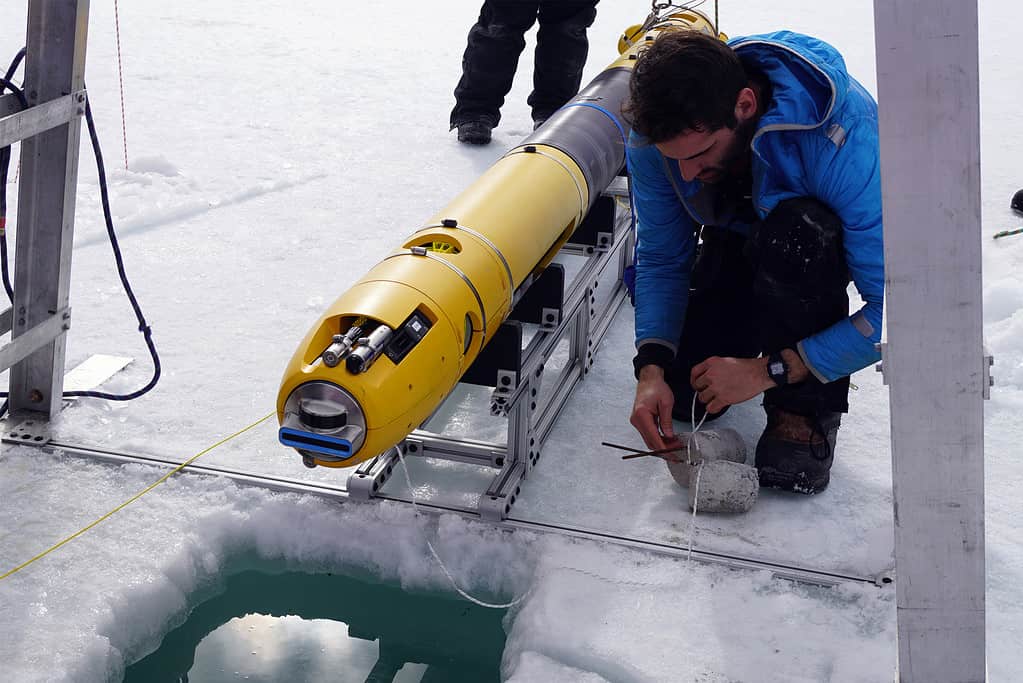The ice shelves upon which the Doomsday Glacier of Antarctica rests are melting fast, causing the disintegration of a gigantic ice body equal to the size of the US state of Florida. The melting of the Thwaites Glacier (often referred to as the ‘Doomsday Glacier’) is a matter of concern among scientists because it can lead to a dangerous rise in sea levels across the globe. It’s called the Doomsday Glacier because if it melts, we’re in trouble.
But there’s still much we don’t properly understand about this glacier. This is where this uncanny robot comes in.

A team of international researchers has been using a torpedo-shaped robot named Icefin to understand the factors contributing to the melting of the ice shelf beneath the Thwaites glacier. This unique under-ice robot has been able to explore grounding zones (areas between the ice sheets and free-floating ice shelf) that were previously inaccessible.
According to the researchers, in the last two decades, the grounding zone of Thwaites has moved back by about 14 km, putting the glacier at risk of facing an irreversible loss of ice mass.
If nothing is done to prevent this loss, the global sea levels could rise by over 1.64 feet (0.5 m) in the coming years, submerging several towns, cities, islands, and countries. The researchers recently published two studies that reveal the various changes noticed by Icefin beneath the Doomsday Glacier. These findings could play an important role in increasing our understanding of the ice shelf that’s keeping the Doomsday Glacier intact.
What’s Icefin and how does it work?
Icefin is a 12 feet (3.65 m) long tube-shaped robot that can go up to a depth of 3,280 feet (1 km) below the ice and study the environment beneath a glacier in detail. Its first prototype was developed by scientists at Georgia University of Technology in 2014 and later the robot was given to Cornell University.
Currently, the study authors are using Icefin to study ice shelves in Antarctica. The robot collects information beneath the glaciers using HD cameras, sonar, pH monitors, laser ranging systems, and numerous other sensors.
Icefin can also be customized to add or remove parts as per the requirement of a mission. The robot is remotely controlled and it works perfectly alongside radar systems, search vehicles, and various other machines that scientists use to study the glaciers in Antarctica. The Cornell team dug a 1,969 feet deep borehole to deploy Icefin near the ice shelf of Thwaites.
“Icefin is collecting data as close to the ice as possible in locations no other tool can currently reach. It’s showing us that this system is very complex and requires a rethinking of how the ocean is melting the ice, especially in a location like Thwaites,” said Peter Washam, one of the study authors and a research scientist at Cornell.
Here’s what Icefin found
The data collected by Icefin reveals that contrary to what many computer models suggest, the rate of ice melting is slow beneath the ice shelf but fast in sections of the glacier that has cracks and rifts. These sections allow the flow of warm ocean currents through them which heat them and often leave salt behind causing the cracks to grow further.
Icefin also found that melting is rapid around the glacier terraces (icy segments of a glacier that act as a path to a water body near the glacier’s base) and crevasses. This further confirms that ice loss is happening fast at the weakest points on the outside of the Thwaites glacier. Thanks to Icefin, we now know that it’s the continuous weakening of these cracks and crevasses which is causing the fast disintegration of the Doomsday Glacier.
“Our results are unexpected, but the glacier is still in trouble. If an ice shelf and a glacier are in balance, the ice coming off the continent will match the amount of ice being lost through melting and iceberg calving. What we have found is that despite small amounts of melting there is still rapid glacier retreat, so it seems that it doesn’t take a lot to push the glacier out of balance,” said Peter Davis, one of the study authors and an oceanographer.
The study authors further reveal that Icefin has helped them understand both the scale of melting and the zones where melting is happening in the glaciers. These findings could play an important role in devising better strategies to mitigate the effects of climate change across the globe.
Excited by these results, the researchers are now developing a new fourth-generation model of Icefin in association with NASA. This new version could be used for studying the frozen moons of Jupiter and Saturn.
The papers revealing the findings of Icefin can be viewed here and here.






